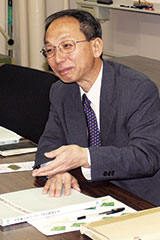Era da metrologia de superfície com aparelhos óticos
Contact-Type Measurement
Surface irregularities can significantly impact the quality and performance of industrial products; these irregularities can then impact the value of such products. Industrial manufacturing requires advanced machining technologies, product quality testing, and machining process management. When creating a surface, there will be a target range, an instrument for seeing that range, and a required method. The method for examining this quality is measurement, and the contact-type instrument (contact stylus) is the tool most typically used to perform this measurement. Contact-type measurement detects irregularities by moving the tip of a stylus directly across the measured surface, which leads to highly reliable measurement data. The standards developed for such measurement have helped improve the supply and reliability of industrial products.
From Contact-Type to Light
Contact-type techniques achieve measurement with high reliability, but as the stylus touches the measured surface, it is limited in reaching the bottom of the valleys in the surface texture due to the size of the tip, in addition the tip is further rounded by friction. Also, measurement pressure can damage the measured surface. As a result, the measurement can differ from actual surface roughness. Today, diamonds with high friction resistance are used as styli, with tip shapes made as narrow as possible, allowing fine adjustment of measurement pressure. The precision of the instruments themselves has dramatically increased, and progress is being made in standardizing the precision of contact-type instruments, which contributes to higher quality in industrial products. However, not all problems associated with contact-type measurement have been overcome. As higher product quality is expected, the development of finer surface roughness assessment methods continues, along with an emerging shift from “line” to “area” roughness. Today’s manufacturers have increase expectations about the use of “light” in place of contact-type styli as the core of the next generation of surface roughness measurement.
Industry Turning to Light
About 30 years ago, when standardization of contact-type measurement was underway, we encountered our first measuring instrument that used light. The advantages of light are that it is eternally free of friction, does not damage the measured surface, measures rapidly, and utilizes easy-to-use instrumentation. These benefits, combined with the novelty of the technology, raised high expectations. Initial measurement results, however, were very different from measurement data obtained with
contact-type instruments. It became clear that the discrepancy in measurement data was due to light-specific phenomena, such as variations in light scattering and the amount of reflected light. Today, measurement with light has become more precise and the measurement data obtained with light closer to that obtained from contact-type instruments.
The advantages of light are that it is non-contact, capable of areal measurement, and can measure at high speed. Non-contact and areal measurement make it possible to quickly measure the full area of industrial products that are soft, thin, or wide without damaging them. Measurement with light is becoming essential for mass-produced industrial products that are expected to be uniform and homogeneous.
Light is used for displays, electronics, films, and similar products where destruction during measurement is a concern, and also for more robust samples such as diesel engine nozzles. Measurement with light also has a number of environmental advantages.
Delivering Satisfactory Reliability
The Japanese Industrial Standard (JIS) for areal roughness measurement only regulates two-dimensional parameters, and no clear standards exist for three-dimensional parameters. Work by European research groups on the standardization of three-dimensional parameters is progressing, and it now appears that the wider use of three-dimensional parameters, and the provision of adequately reliable information on three-dimensional analysis, are necessary.
Machining precision continues to improve with recent advances in machining technology, and there is demand for high-precision roughness measurement instruments. There are laser microscopes today that can measure surface roughness with light condensed into the extremely small spot diameter of a laser beam, achieving nanometer-level resolution in the vertical direction, and areal rather than linear assessment is becoming the mainstream in measurement assessment. We are now in an age where
high-speed areal and full-area measurement with light can deliver satisfactory reliability.
 |
Dr. Kazuhisa Yanagi is a professor of faculty of engineering, department of mechanical engineering at Nagaoka University of Technology.
Publications by Prof. Kazuhisa Yanagi with Olympus LEXT Laser Scanning Confocal Microscope
|